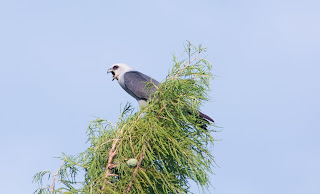Translate
Monday, August 19, 2019
Final Green Heron Photos and Mississippi Kites Versus Northern Mockingbird
Green Heron 2 out of 3
081119
0730-0811/81-82 F/heat index 87 F/partly cloudy/SE-6/75-7 % RH/29.89-29.91 Hg and rising
Clutch 3 Green Herons are growing well and are flighted. Their fledging has been rapid, considering that they were in the shaded area of the northeast segment of Heron Cove.
Green Heron 1 of 3
Green Heron 2 and 3 of 3
Solitary Sandpiper
081219
0722-0902/82-88 F/heat index 91 F/clear/SSW-10/67-62% RH/29.82-29.79 Hg and steady
Daily photos of young Green Herons will show their rapid growth while flight gets stronger.
The Solitary Sandpiper was located at Veteran's Memorial jetty on the north side. They usually prefer
to be on fresh water mudflats, edges of brushy ponds or ditches, and even on fields with shallow water. This behavior is slightly out of character, yet they commonly come to Boomer Lake area during fall migration.
2 out of 3 Green Heron Fledglings
081419
0727-0904/77-80 F/variable clouds/NW-7/74-72% RH/30.01-30.05 Hg and rising
Every day a few more downy feathers disappear from the Green Heron heads.
Mississippi Kite Vocalizing to Comrades
Hunting Area Insects Like Dragonflies
and Cicadas
081719
0720-0938/82-89 F/heat index 92/var. clouds to partly cloudy/ESE-10/66-61% RH/29.84-29.89 Hg and rising
Mississippi Kite (In Tree)
Northern Mockingbird (In Air)
Ditto, View 2
Mississippi Kite
081819
1040-1202/73-85 F/partly cloudy/S-12/80-74% RH/29.84-29.89 Hg and rising
Writer was out at 0720 and rain was imminent. The furthest I got was to Heron Cove, which was well checked. There were eight Yellow Warblers seen there, which is quite a bit for one area. During the second excursion, no others were found and I went beyond the east side restrooms.
Highlights observed were the Mississippi Kites that were hawking insects from both the power poles and bald cypress trees. The above kite had been harassed by a Northern Mockingbird, as this territory area is his.
Third shot of this kite showed it searching for larger insects like cicadas and dragonflies. When the insects are captured, the kite rapidly pulls off a wing or two to keep them within grasp so they can be consumed on the wing.
Subscribe to:
Post Comments (Atom)









No comments:
Post a Comment